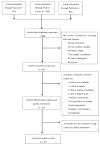Weather Variability and COVID-19 Transmission: A Review of Recent Research
- PMID: 33419216
- PMCID: PMC7825623
- DOI: 10.3390/ijerph18020396
Weather Variability and COVID-19 Transmission: A Review of Recent Research
Abstract
Weather and climate play a significant role in infectious disease transmission, through changes to transmission dynamics, host susceptibility and virus survival in the environment. Exploring the association of weather variables and COVID-19 transmission is vital in understanding the potential for seasonality and future outbreaks and developing early warning systems. Previous research examined the effects of weather on COVID-19, but the findings appeared inconsistent. This review aims to summarize the currently available literature on the association between weather and COVID-19 incidence and provide possible suggestions for developing weather-based early warning system for COVID-19 transmission. Studies eligible for inclusion used ecological methods to evaluate associations between weather (i.e., temperature, humidity, wind speed and rainfall) and COVID-19 transmission. The review showed that temperature was reported as significant in the greatest number of studies, with COVID-19 incidence increasing as temperature decreased and the highest incidence reported in the temperature range of 0-17 °C. Humidity was also significantly associated with COVID-19 incidence, though the reported results were mixed, with studies reporting positive and negative correlation. A significant interaction between humidity and temperature was also reported. Wind speed and rainfall results were not consistent across studies. Weather variables including temperature and humidity can contribute to increased transmission of COVID-19, particularly in winter conditions through increased host susceptibility and viability of the virus. While there is less indication of an association with wind speed and rainfall, these may contribute to behavioral changes that decrease exposure and risk of infection. Understanding the implications of associations with weather variables and seasonal variations for monitoring and control of future outbreaks is essential for early warning systems.
Keywords: COVID-19; humidity; precipitation; seasonality; temperature; weather; wind speed.
Conflict of interest statement
The authors declare no conflict of interest.
Figures




References
-
- Allam Z. Surveying the Covid-19 Pandemic and its Implications. Elsevier; Amsterdam, The Netherlands: 2020. The First 50° days of COVID-19: A Detailed Chronological Timeline and Extensive Review of Literature Documenting the Pandemic; pp. 1–7. - DOI
-
- World Health Organization Timeline of WHO’s Response to COVID-19. [(accessed on 10 October 2020)]; Available online: https://www.who.int/news/item/29-06-2020-covidtimeline.
Publication types
MeSH terms
LinkOut - more resources
Full Text Sources
Other Literature Sources
Medical

